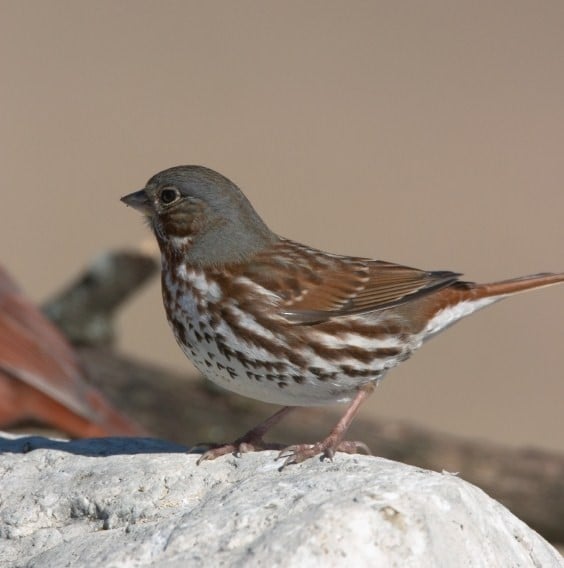Passerella iliaca
OK, it is called a Fox Sparrow because it has the colors of a fox. The question is which fox: a grey fox or a red fox? Well, both! And don’t just look for sparrows that look like the accompanying photograph. This is a bird whose plumage varies greatly across their North American range. Currently there are 18 subspecies of the Fox Sparrow that have been identified. What do they have in common? They are beautiful and regular visitors to bird feeders. Our vignette will describe the eastern birds.
If you reside in the northeast, the first thing to understand is that the Fox Sparrow is a migratory species. Summer breeding territories are located along the upper edge of the continent within the northern boreal forests of Canada. Winters are spent from mid-Pennsylvania to northern Florida, as well as along the coast of New England. That means that for most of us, our chance to view this beauty occurs in the spring and again in the fall.
Fox Sparrows are shy creatures that are associated with dense vegetation. Nests are typically located on the ground or in bushes, and are well concealed and difficult to find. Much of their foraging for food occurs on the ground and within, or close to protective cover. Fox Sparrows hunt for edible tidbits by scratching in leaf litter and other vegetative debris. Their foraging method is fun to watch. They hop into the air and scratch backwards with both feet to expose potential food on the ground. When they venture out to a spot under your feeders, you will see this interesting behavior.
During their warm weather sojourn in the north, Fox Sparrows are primarily insectivores. During the winter season they supplement any insects they find with seeds, fruits, and buds. It is during this period that they can be found visiting bird feeding stations. Look for them on the ground. If you have a platform feeder placed on the ground, Aspen Song® Value Blend provides the sizes and types of seeds that sparrows readily consume. If you have pole-mounted or hanging feeders, expect Fox Sparrows to be “hop-scratching” under them as they forage for spilled seeds.
The transition periods of spring and fall can often include sudden snowfalls and periods of freezing rain. These times are hard on ground-feeding species like Fox Sparrows. Your feeders may be an important means for their survival. During such times, keep a sharp eye out for the elusive “fox” of the backyard!
Reference
Weckstein, Jason D., Donald E. Kroodsma and Robert C. Faucett. 2002. Fox Sparrow (Passerella iliaca), The Birds of North America Online (A. Poole, Ed.). Ithaca: Cornell Lab of Ornithology.
